Liquid SUZUKI GRAND VITARA 2001 2.G Owners Manual
[x] Cancel search | Manufacturer: SUZUKI, Model Year: 2001, Model line: GRAND VITARA, Model: SUZUKI GRAND VITARA 2001 2.GPages: 656, PDF Size: 14.31 MB
Page 28 of 656
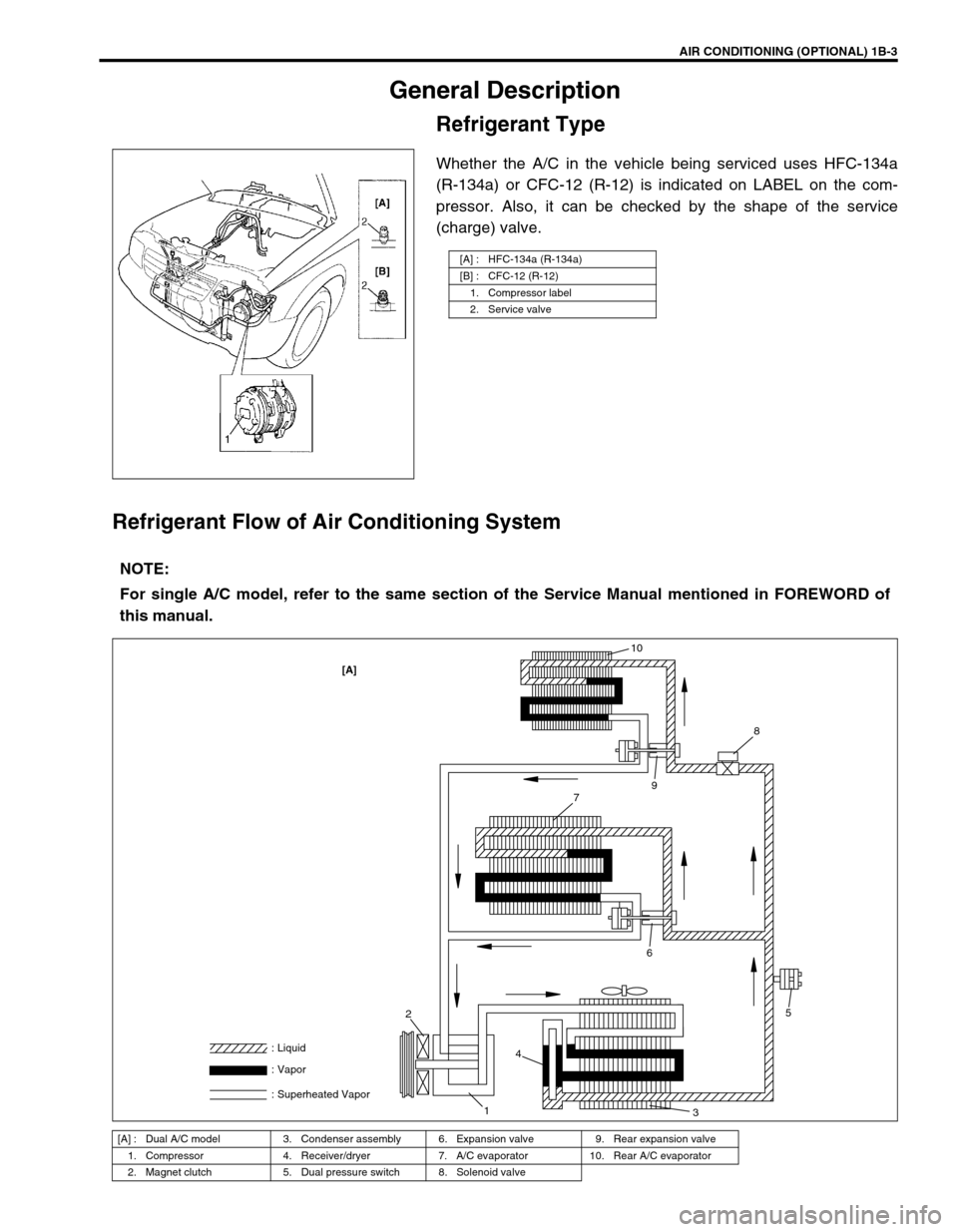
AIR CONDITIONING (OPTIONAL) 1B-3
General Description
Refrigerant Type
Whether the A/C in the vehicle being serviced uses HFC-134a
(R-134a) or CFC-12 (R-12) is indicated on LABEL on the com-
pressor. Also, it can be checked by the shape of the service
(charge) valve.
Refrigerant Flow of Air Conditioning System
[A] : HFC-134a (R-134a)
[B] : CFC-12 (R-12)
1. Compressor label
2. Service valve
NOTE:
For single A/C model, refer to the same section of the Service Manual mentioned in FOREWORD of
this manual.
[A] : Dual A/C model 3. Condenser assembly 6. Expansion valve 9. Rear expansion valve
1. Compressor 4. Receiver/dryer 7. A/C evaporator 10. Rear A/C evaporator
2. Magnet clutch 5. Dual pressure switch 8. Solenoid valve
[A]10
8
9
5
7
6
3
2
14 : Liquid
: Vapor
: Superheated Vapor
Page 29 of 656
![SUZUKI GRAND VITARA 2001 2.G Owners Manual 1B-4 AIR CONDITIONING (OPTIONAL)
Major Components And Location
[A] : Dual A/C model 6. Receiver/dryer 13. Suction pipe 20. Ventilation air
[B] : Single A/C model 7. Front expansion valve 14. Discharge SUZUKI GRAND VITARA 2001 2.G Owners Manual 1B-4 AIR CONDITIONING (OPTIONAL)
Major Components And Location
[A] : Dual A/C model 6. Receiver/dryer 13. Suction pipe 20. Ventilation air
[B] : Single A/C model 7. Front expansion valve 14. Discharge](/img/20/7584/w960_7584-28.png)
1B-4 AIR CONDITIONING (OPTIONAL)
Major Components And Location
[A] : Dual A/C model 6. Receiver/dryer 13. Suction pipe 20. Ventilation air
[B] : Single A/C model 7. Front expansion valve 14. Discharge pipe 21. Rear A/C air
1. Front cooling unit 8. Heater unit 15. Recirculation air 22. Room air
2. Front A/C evaporator 9. Rear A/C unit 16. Fresh air 23. Solenoid valve
3. Front blower fan motor 10. Rear blower fan motor 17. Defroster air 24. Rear A/C evaporator
4. Compressor 11. Rear expansion valve 18. Demister air
5. Condenser assembly 12. Liquid pipe 19. Foot air
17 17
18 18
16 [A]
[B]15
21
2211
23
9
24
10 141320
21
19 19
4 12
6 312
78
17 17
18 18
16
15
20
19 19 1
2
8 5
7
12
6
513
4 14
Page 30 of 656
![SUZUKI GRAND VITARA 2001 2.G Owners Manual AIR CONDITIONING (OPTIONAL) 1B-5
[A] : Dual A/C LH steering model 4. Condenser 11. Low pressure charge valve
[B] : Dual A/C RH steering model 5. Sight glass 12. Floor liquid pipe
[C] : Single A/C LH s SUZUKI GRAND VITARA 2001 2.G Owners Manual AIR CONDITIONING (OPTIONAL) 1B-5
[A] : Dual A/C LH steering model 4. Condenser 11. Low pressure charge valve
[B] : Dual A/C RH steering model 5. Sight glass 12. Floor liquid pipe
[C] : Single A/C LH s](/img/20/7584/w960_7584-29.png)
AIR CONDITIONING (OPTIONAL) 1B-5
[A] : Dual A/C LH steering model 4. Condenser 11. Low pressure charge valve
[B] : Dual A/C RH steering model 5. Sight glass 12. Floor liquid pipe
[C] : Single A/C LH steering model 6. Refrigerant (dual) pressure sensor 13. Floor suction pipe
[D] : Single A/C RH steering model 7. Discharge pipe 14. Rear A/C unit
1. Front cooling unit 8. Liquid pipe 15. Rear A/C duct No.1
2. Heater unit 9. Suction pipe 16. Rear A/C duct No.2
3. Compressor 10. High pressure charge valve
[A]
[B]
[C][D]
10
7
9 3 4 6 5 1181
213
12 16
1514
1 2
13
12 16
1514
7
10
5
6
4
38
9 11
1 2
7
10
5
6
4
38
9 11
10
7
9 3 4 6 5 1181
2
Page 44 of 656
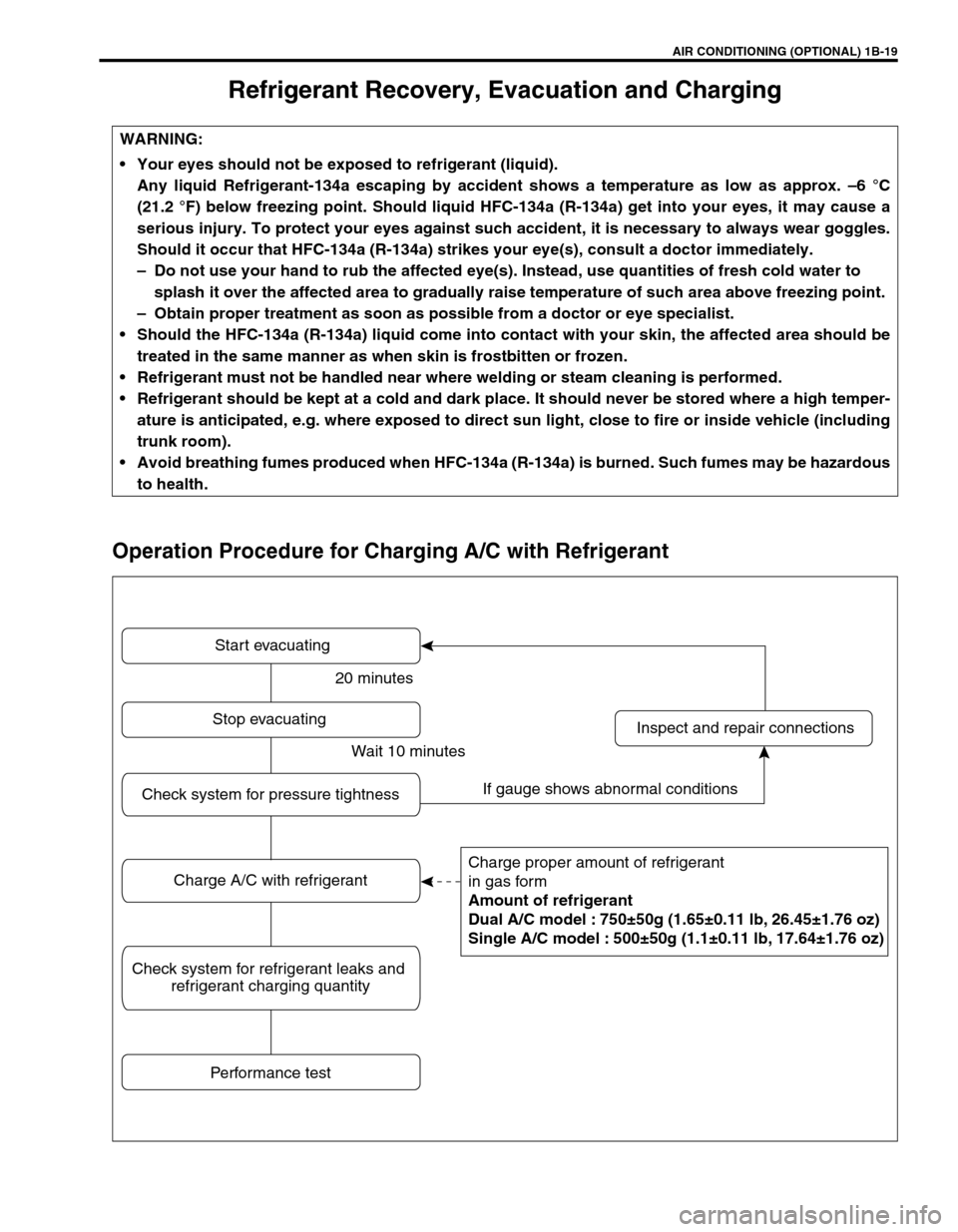
AIR CONDITIONING (OPTIONAL) 1B-19
Refrigerant Recovery, Evacuation and Charging
Operation Procedure for Charging A/C with Refrigerant
WARNING:
Your eyes should not be exposed to refrigerant (liquid).
Any liquid Refrigerant-134a escaping by accident shows a temperature as low as approx. –6 °C
(21.2 °F) below freezing point. Should liquid HFC-134a (R-134a) get into your eyes, it may cause a
serious injury. To protect your eyes against such accident, it is necessary to always wear goggles.
Should it occur that HFC-134a (R-134a) strikes your eye(s), consult a doctor immediately.
–Do not use your hand to rub the affected eye(s). Instead, use quantities of fresh cold water to
splash it over the affected area to gradually raise temperature of such area above freezing point.
–Obtain proper treatment as soon as possible from a doctor or eye specialist.
Should the HFC-134a (R-134a) liquid come into contact with your skin, the affected area should be
treated in the same manner as when skin is frostbitten or frozen.
Refrigerant must not be handled near where welding or steam cleaning is performed.
Refrigerant should be kept at a cold and dark place. It should never be stored where a high temper-
ature is anticipated, e.g. where exposed to direct sun light, close to fire or inside vehicle (including
trunk room).
Avoid breathing fumes produced when HFC-134a (R-134a) is burned. Such fumes may be hazardous
to health.
Start evacuating
Charge proper amount of refrigerant
in gas form
Amount of refrigerant
Dual A/C model : 750±50g (1.65±0.11 lb, 26.45±1.76 oz)
Single A/C model : 500±50g (1.1±0.11 lb, 17.64±1.76 oz)
Inspect and repair connections Stop evacuating
Performance test
Check system for pressure tightness
Charge A/C with refrigerant
Check system for refrigerant leaks and
refrigerant charging quantity
20 minutes
Wait 10 minutes
If gauge shows abnormal conditions
Page 47 of 656
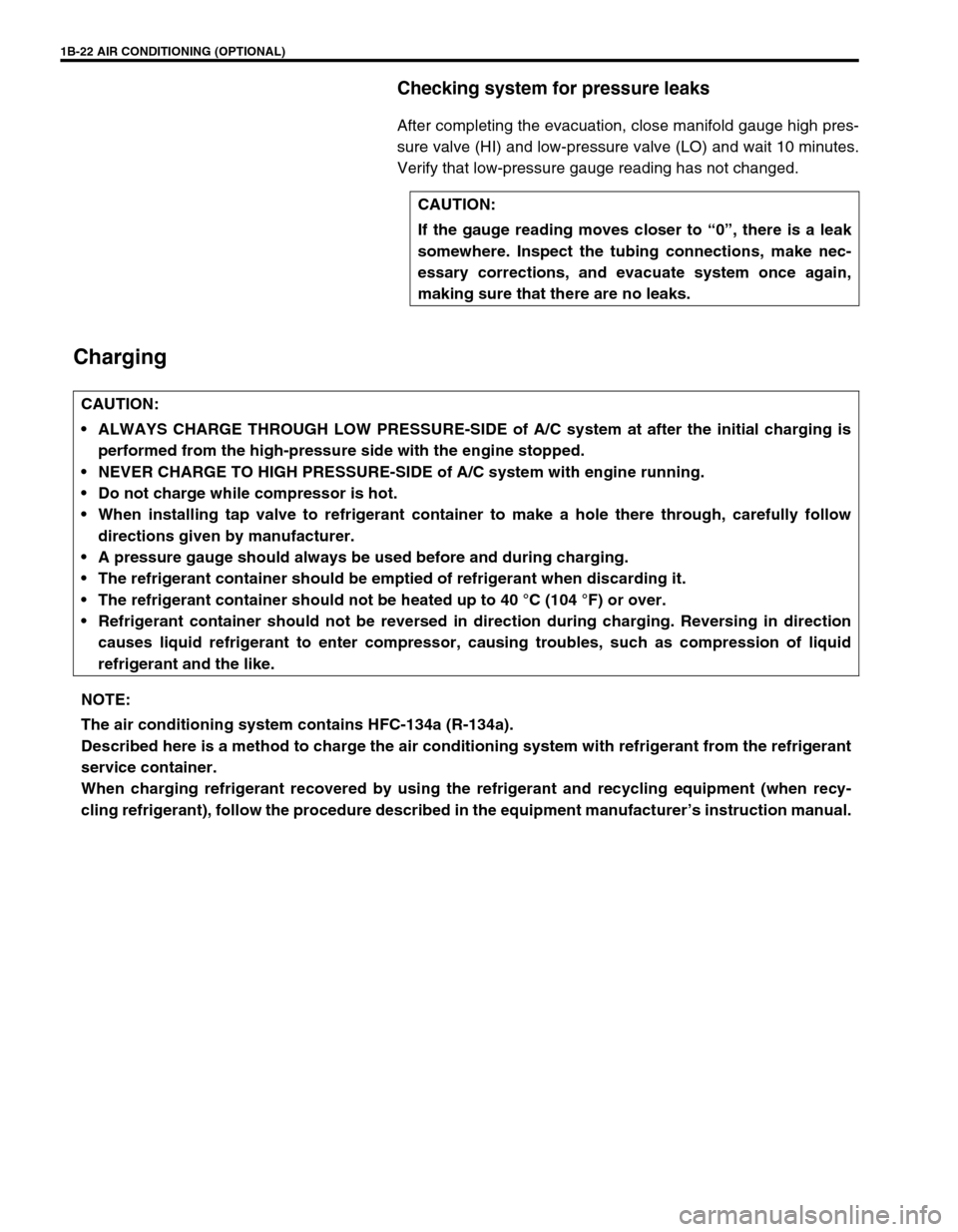
1B-22 AIR CONDITIONING (OPTIONAL)
Checking system for pressure leaks
After completing the evacuation, close manifold gauge high pres-
sure valve (HI) and low-pressure valve (LO) and wait 10 minutes.
Verify that low-pressure gauge reading has not changed.
Charging
CAUTION:
If the gauge reading moves closer to “0”, there is a leak
somewhere. Inspect the tubing connections, make nec-
essary corrections, and evacuate system once again,
making sure that there are no leaks.
CAUTION:
ALWAYS CHARGE THROUGH LOW PRESSURE-SIDE of A/C system at after the initial charging is
performed from the high-pressure side with the engine stopped.
NEVER CHARGE TO HIGH PRESSURE-SIDE of A/C system with engine running.
Do not charge while compressor is hot.
When installing tap valve to refrigerant container to make a hole there through, carefully follow
directions given by manufacturer.
A pressure gauge should always be used before and during charging.
The refrigerant container should be emptied of refrigerant when discarding it.
The refrigerant container should not be heated up to 40 °C (104 °F) or over.
Refrigerant container should not be reversed in direction during charging. Reversing in direction
causes liquid refrigerant to enter compressor, causing troubles, such as compression of liquid
refrigerant and the like.
NOTE:
The air conditioning system contains HFC-134a (R-134a).
Described here is a method to charge the air conditioning system with refrigerant from the refrigerant
service container.
When charging refrigerant recovered by using the refrigerant and recycling equipment (when recy-
cling refrigerant), follow the procedure described in the equipment manufacturer’s instruction manual.
Page 50 of 656
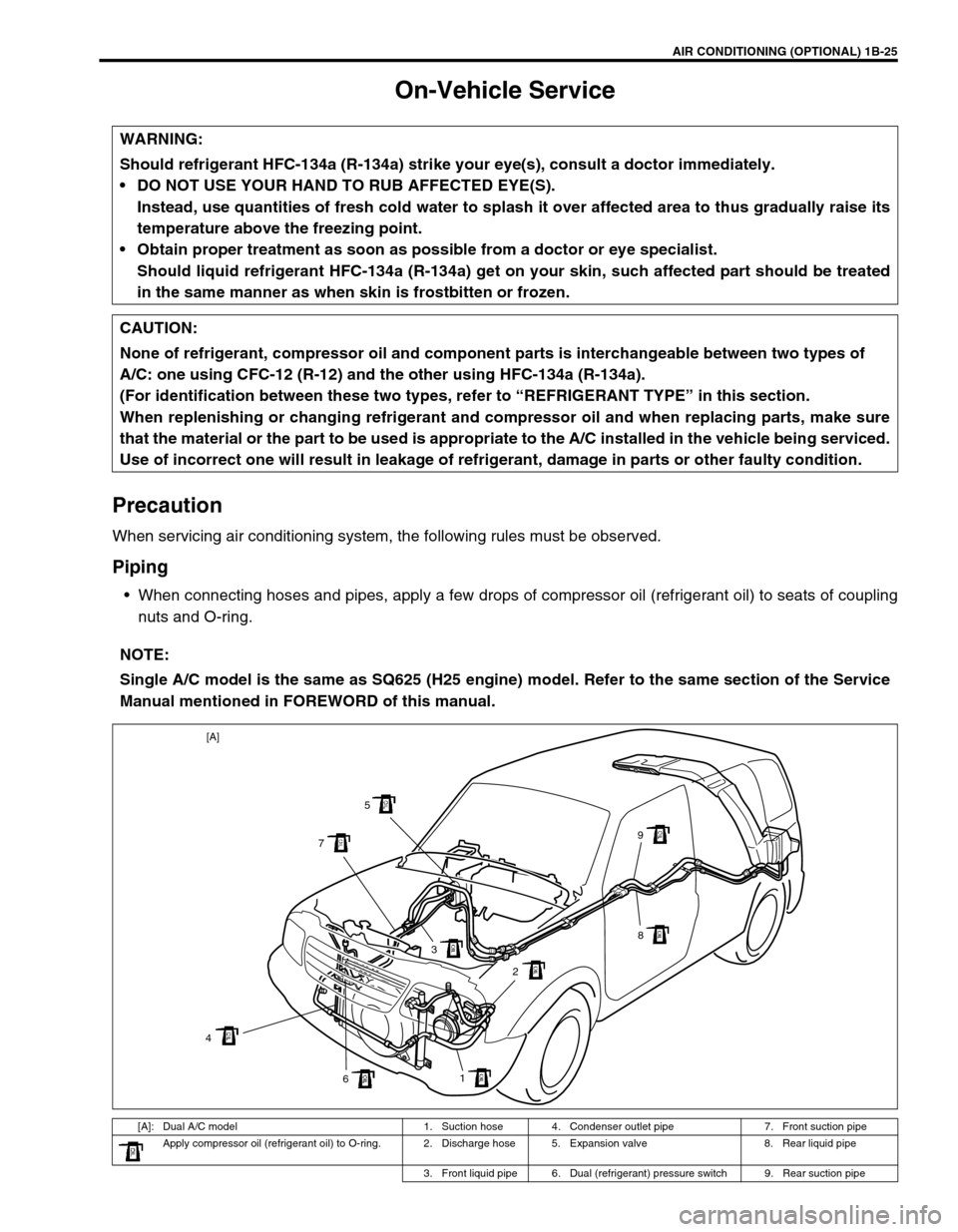
AIR CONDITIONING (OPTIONAL) 1B-25
On-Vehicle Service
Precaution
When servicing air conditioning system, the following rules must be observed.
Piping
When connecting hoses and pipes, apply a few drops of compressor oil (refrigerant oil) to seats of coupling
nuts and O-ring. WARNING:
Should refrigerant HFC-134a (R-134a) strike your eye(s), consult a doctor immediately.
DO NOT USE YOUR HAND TO RUB AFFECTED EYE(S).
Instead, use quantities of fresh cold water to splash it over affected area to thus gradually raise its
temperature above the freezing point.
Obtain proper treatment as soon as possible from a doctor or eye specialist.
Should liquid refrigerant HFC-134a (R-134a) get on your skin, such affected part should be treated
in the same manner as when skin is frostbitten or frozen.
CAUTION:
None of refrigerant, compressor oil and component parts is interchangeable between two types of
A/C: one using CFC-12 (R-12) and the other using HFC-134a (R-134a).
(For identification between these two types, refer to “REFRIGERANT TYPE” in this section.
When replenishing or changing refrigerant and compressor oil and when replacing parts, make sure
that the material or the part to be used is appropriate to the A/C installed in the vehicle being serviced.
Use of incorrect one will result in leakage of refrigerant, damage in parts or other faulty condition.
NOTE:
Single A/C model is the same as SQ625 (H25 engine) model. Refer to the same section of the Service
Manual mentioned in FOREWORD of this manual.
[A]: Dual A/C model 1. Suction hose 4. Condenser outlet pipe 7. Front suction pipe
Apply compressor oil (refrigerant oil) to O-ring. 2. Discharge hose 5. Expansion valve 8. Rear liquid pipe
3. Front liquid pipe 6. Dual (refrigerant) pressure switch 9. Rear suction pipe
1
6 43 75
9
8
2 [A]
Page 51 of 656

1B-26 AIR CONDITIONING (OPTIONAL)
Never use heat for bending pipes. When bending a pipe, try to make its bending radius as slight as possible.
Keep internal parts of air conditioning free from moisture and dirt. When disconnecting any line from system,
install a blind plug or cap to the fitting immediately.
When tightening or loosening a fitting, use two wrenches, one for turning and the other for support.
Tighten flared nuts to specified torque.
Tightening torque
8 mm (0.31 in.) pipe : 13 N·m (1.3 kg-m, 9.5 lb-ft)
12.7 mm (0.5 in.) pipe : 22 N·m (2.2 kg-m, 16.0 lb-ft)
16 mm (0.63 in.) pipe : 33 N·m (3.3 kg-m, 24.0 lb-ft)
Route drain hose so that drained water does not make any contact to vehicle components.
Handling refrigerant HFC-134a (R-134a)
When handling refrigerant, always wear goggles to protect your eyes.
Avoid you direct contact to liquid refrigerant.
Do not heat refrigerant container higher than 40 °C (104 °F).
Do not discharge refrigerant into atmosphere.
Do not allow liquid refrigerant to touch bright metals. Refrigerant combined with moisture is corrosive and
will tarnish surfaces of bright metals including chrome.
After recovering refrigerant from system, the amount of compressor oil removed must be measured and the
same amount added to the system.
Refrigerant recovery
When discharging refrigerant out of A/C system, always recover it by using refrigerant recovery and recycling
equipment. Discharging refrigerant HFC-134a (R-134a) into atmosphere would cause adverse effect to environ-
ments.
Refrigerant charge
Charge a proper amount of refrigerant to A/C system according to charging procedure described in recovery,
evacuation and charging.NOTE:
When handling recovery and recycling equipment, be sure to follow the instruction manual for the
equipment.
CAUTION:
Do not perform an additional refrigerant charging to A/C system. This cause it to overcharge.
Page 53 of 656

1B-28 AIR CONDITIONING (OPTIONAL)
Rear A/C Unit (Rear A/C Evaporator)
REMOVAL
1) Disconnect negative (–) cable at battery.
2) Recover refrigerant by using recovery and recycling equip-
ment. Be sure to follow the instruction manual for the equip-
ment.
The amount of compressor oil removed must be measured
and the same amount added to the system.
3) Remove rear luggage mat end garnish (1), rear luggage box
(2) (if equipped), rear side sill scuff (3) rear quarter lower trim
(4) and rear quarter upper trim (5).
1. Rear blower fan cover 6. Rear A/C unit mounting clip 11. Solenoid valve mounting bracket Do not reuse
2. Rear A/C unit mounting bush 7. Rear blower motor assembly 12. Solenoid valve Apply compressor
(refrigerant)
oil to O-ring
3. Rear blower fan resistor 8. Rear A/C evaporator temperature controller 13. Rear liquid pipe
4. Rear A/C unit cover 9. Rear expansion valve 14. O-ring
5. Rear A/C evaporator 10. Rear suction pipe 15. Packing
6
7
15
10
14
12
13
14
14
14
11
8
9
4
6
5
41
232
5
4
3
2
1
Page 54 of 656
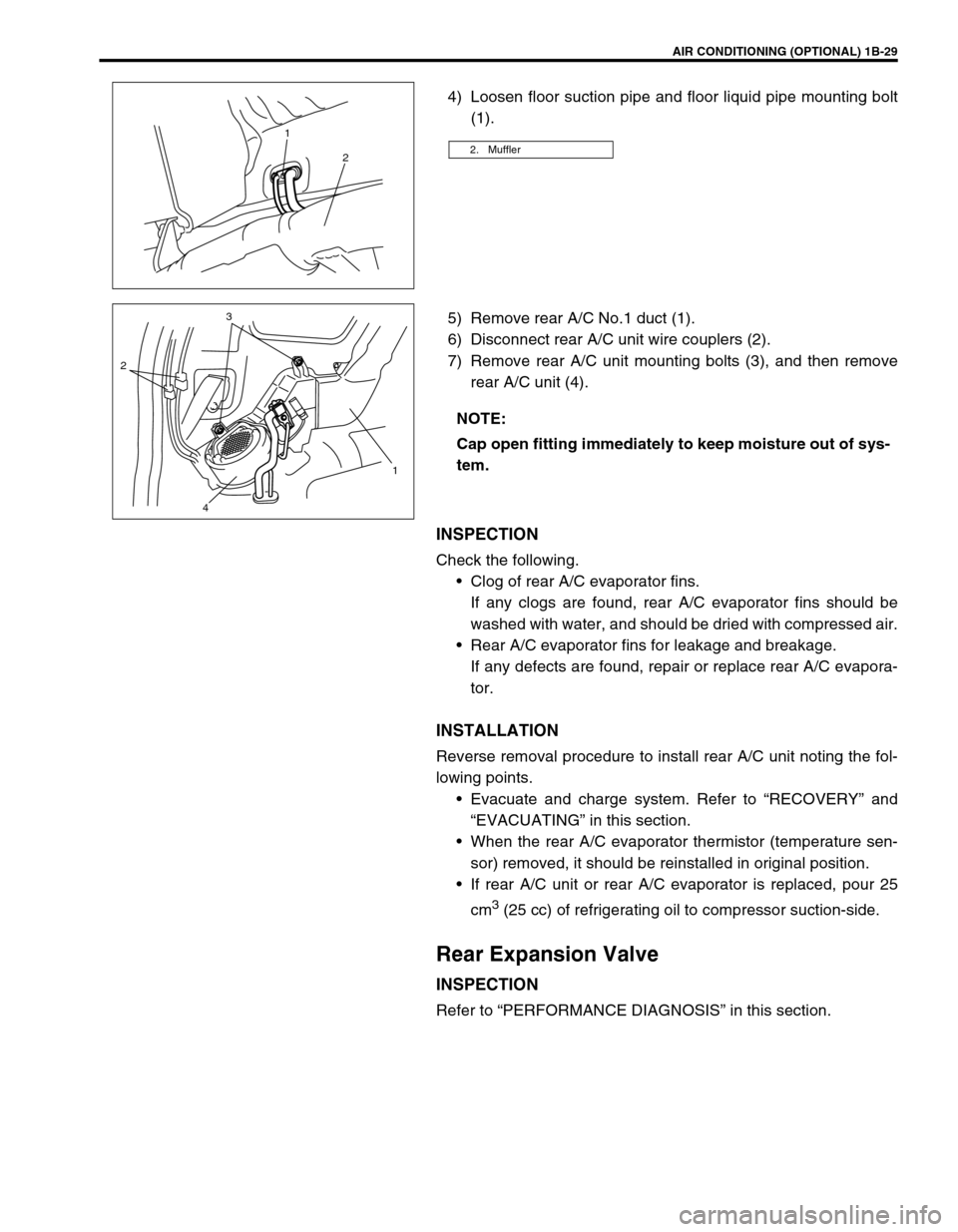
AIR CONDITIONING (OPTIONAL) 1B-29
4) Loosen floor suction pipe and floor liquid pipe mounting bolt
(1).
5) Remove rear A/C No.1 duct (1).
6) Disconnect rear A/C unit wire couplers (2).
7) Remove rear A/C unit mounting bolts (3), and then remove
rear A/C unit (4).
INSPECTION
Check the following.
Clog of rear A/C evaporator fins.
If any clogs are found, rear A/C evaporator fins should be
washed with water, and should be dried with compressed air.
Rear A/C evaporator fins for leakage and breakage.
If any defects are found, repair or replace rear A/C evapora-
tor.
INSTALLATION
Reverse removal procedure to install rear A/C unit noting the fol-
lowing points.
Evacuate and charge system. Refer to “RECOVERY” and
“EVACUATING” in this section.
When the rear A/C evaporator thermistor (temperature sen-
sor) removed, it should be reinstalled in original position.
If rear A/C unit or rear A/C evaporator is replaced, pour 25
cm
3 (25 cc) of refrigerating oil to compressor suction-side.
Rear Expansion Valve
INSPECTION
Refer to “PERFORMANCE DIAGNOSIS” in this section.
2. Muffler
1
2
NOTE:
Cap open fitting immediately to keep moisture out of sys-
tem.
23
1
4
Page 55 of 656
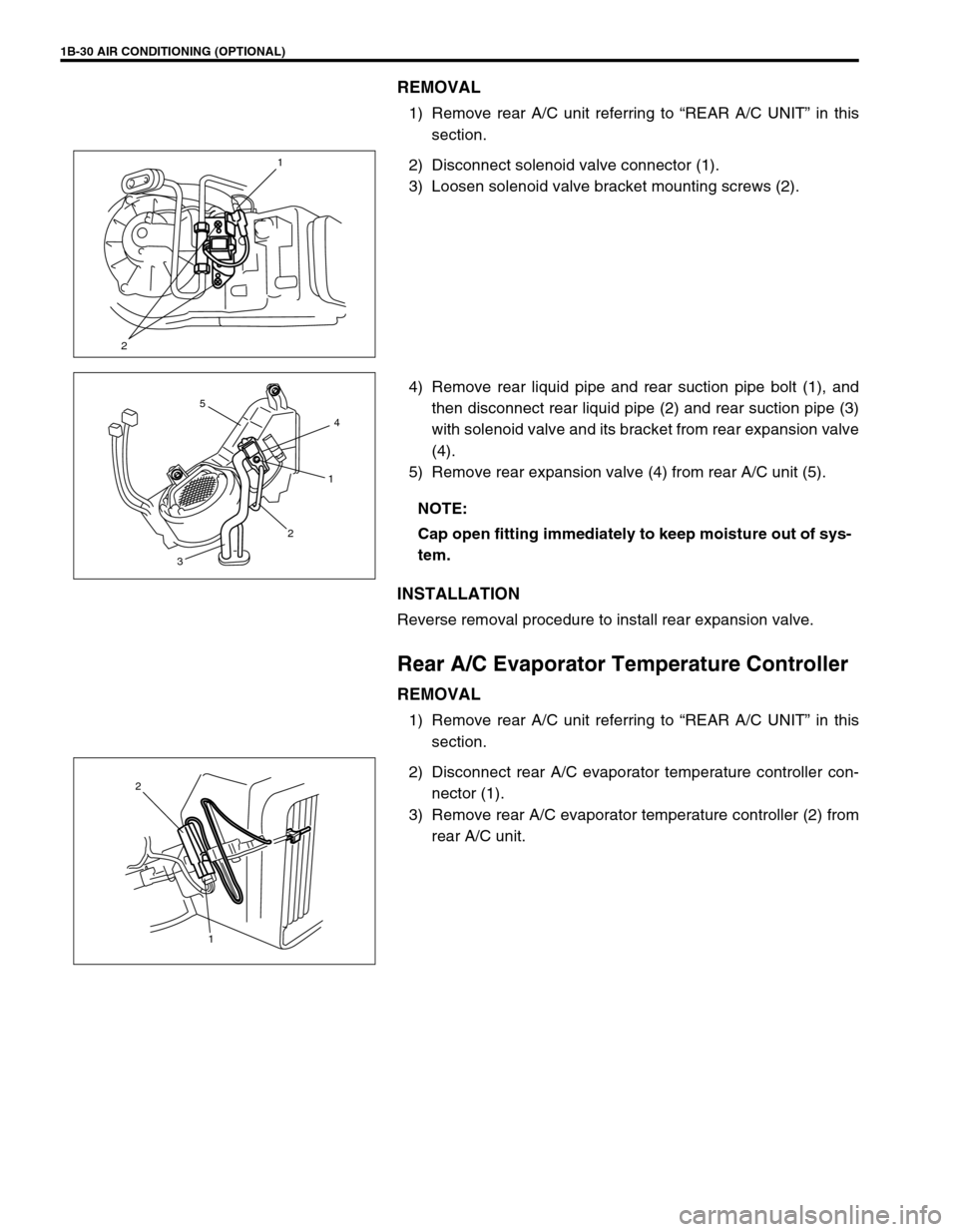
1B-30 AIR CONDITIONING (OPTIONAL)
REMOVAL
1) Remove rear A/C unit referring to “REAR A/C UNIT” in this
section.
2) Disconnect solenoid valve connector (1).
3) Loosen solenoid valve bracket mounting screws (2).
4) Remove rear liquid pipe and rear suction pipe bolt (1), and
then disconnect rear liquid pipe (2) and rear suction pipe (3)
with solenoid valve and its bracket from rear expansion valve
(4).
5) Remove rear expansion valve (4) from rear A/C unit (5).
INSTALLATION
Reverse removal procedure to install rear expansion valve.
Rear A/C Evaporator Temperature Controller
REMOVAL
1) Remove rear A/C unit referring to “REAR A/C UNIT” in this
section.
2) Disconnect rear A/C evaporator temperature controller con-
nector (1).
3) Remove rear A/C evaporator temperature controller (2) from
rear A/C unit.
21
NOTE:
Cap open fitting immediately to keep moisture out of sys-
tem.
4
1
2
3
5
1 2